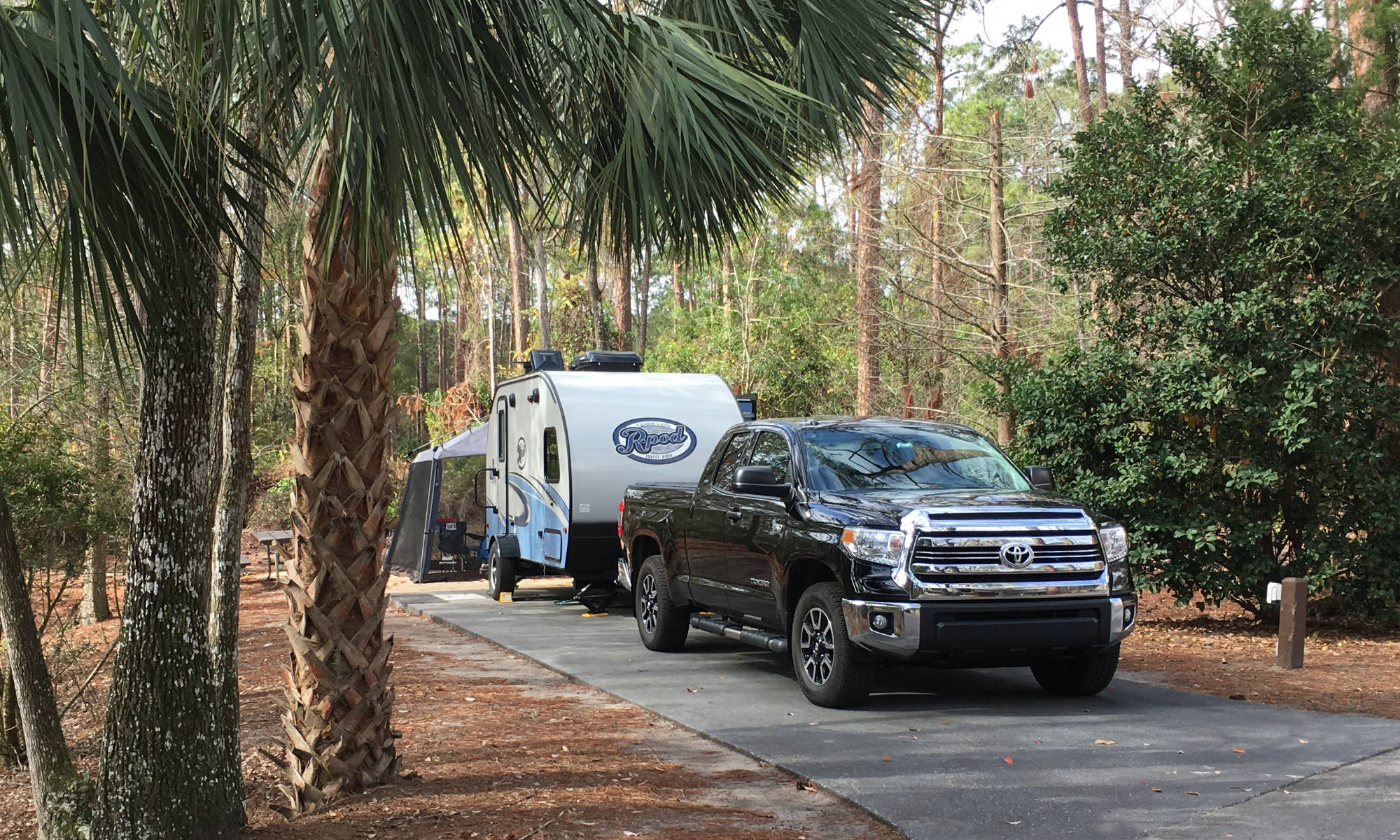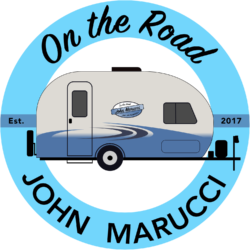Click here to sign up for reminders when new blogs are posted.
The below process steps for RV winterization are performed on my 2020 Keystone Bullet 243BHS. Many of these steps apply to RVs in general. The steps below are shown in the Keystone Bullet Winterization video on the channel. A link to this video is at the bottom of this blog along with a process document in pdf downloadable format.
Here are the tools and supplies you will need to do this job:
-
- A small air compressor that can adjust to 20 psi
- A blowout plug* to attach to the air compressor
- 2-3 gallons of RV food-safe pink antifreeze
- Philips and flathead screwdrivers
- Towels
- Small water buckets*
- Flojet Water Pump Port Fitting* (not mentioned in the video)
- Nylon Poly Tubing* (not mentioned in the video)
Part 1 – Remove all water from the RV
-
- Empty Waste Holding Tanks. Make sure the black and gray wastewater tanks are empty. We did this on our last camping trip of the season and were able to take considerable time to flush the black tank. I highly recommend this before starting this process.
- Drain Freshwater Tank. Outside and underneath the trailer, open your freshwater tank’s drain and allow it to empty. This may take a while depending on how much fresh water is in the tank. You may have to reach under the trailer quite a ways to reach the valve.
- Clear Water Pump Line. Turn on the water pump and open a faucet to suck up any remaining water in the line between the freshwater tank and the pump. From the time you see water flowing to when it begins to spit air may be 30 seconds or so. The faucet may spit air for few minutes as it empties any remaining fresh water in the line. Use a small bucket in the sink to catch the water so it doesn’t go into the gray water tank. When it finishes clearing the line, turn the water pump back off.
- Drain Low-Point Drains. Open both low-point drains underneath the camper. Again, these may be a bit tough to reach. Then open several faucets to allow air in the system to drain water through the low-point drains. You should see water come out of the low point valves as the system drains.
- Drain Hot Water Tank. With the low-point drains opened, open the pressure release value on the water heater, this will allow the hot water tank to drain of the six gallons it holds. If you have a water heater with an anode rod, remove it to allow the hot water tank to drain, but remember to release the pressure from the tank first.
- Blow Out City Water Line. With the low point drains still opened and faucets re-closed, attach a blowout plug to the city water connection. This has an air inlet on one end like the valve stems on your tires, and threads to attach to the water connection. Apply low pressure air (about 20 psi) for several seconds using an air compressor. You should see more water pushed out through the low-point drains. You can get a blowout plug from our Amazon storefront if needed.
- Blow Out Black Tank Flush Line. Move the blow out plug from the city water inlet to the black tank inlet. Apply low pressure air (about 20 psi) for several seconds to the black-tank flush inlet. The interior lines for the black tank flush may allow some water to remain in the lines if they are not blown out. This will only push a minimal amount of water into the black tank.
- Cover Water Inlets. Remove the blow-out plug and remember to cap the city water and black tank flush line inlets.
Part 2 – Add RV Pink Antifreeze
-
- Bypass Hot Water Tank. Locate the panel in front of the hot water tank and remove the panel. The valve for the hot water tank is inside the trailer – for my Keystone Bullet 243BHS, it is under the stove in the kitchen. Identify the tank’s bypass valve and turn the valve to bypass the hot water tank. You will need to bypass the hot water tank, so that you don’t fill it with RV antifreeze unnecessarily.
- Locate and Expose Water Pump. Find the location of the water pump. For my trailer, it is next to the bed on the driver’s side. If you are not sure where the water pump is, turn it on for a moment to locate it by sound. Make sure you turn it back off once it is located.
- Add Siphon Hose to Pump. On the water pump, locate the freshwater intake line. You may already have a hose on this line that can be used to winterize. If not, replace the intake line at the water pump with the siphon line. There is a simple clip on the water pump that loosens and should allow for an easy exchange of the lines. Have a small towel ready for any water spillage.
- Insert Siphon into Antifreeze. Get a gallon jug of RV antifreeze (pink color/food safe), open it and insert the siphon line into the jug. Only use RV (pink) Antifreeze!
- Antifreeze to Low-Point Drains. Turn on the water pump and go outside and verify the low-point drains are dripping pink antifreeze. Once you confirm that you have pink antifreeze coming out of the low point drains, close both low-point drains. You will waste a lot less antifreeze if you have someone helping with this step.
- Antifreeze to Inside Faucets. Turn the water pump on, then open the interior faucets at the sinks and shower, one at a time. Make sure the kitchen sink has antifreeze coming through, that the bathroom sink has antifreeze coming through, that the tub faucet has antifreeze coming through, and that the shower has antifreeze coming through.
- Antifreeze to Toilet. Flush the toilet until the water is pink. Leave some pink antifreeze in the bottom of the toilet to keep the drain valve from drying out over the winter.
- Antifreeze to Outside Faucets. Run antifreeze through the outdoor shower, both hot and cold. Also, run antifreeze through any outdoor water quick connection you may have.
- Drain Siphon Hose. Pull the hose out of the antifreeze bottle just enough so it can’t suck up any antifreeze out of the siphon line. Turn on the water pump and open a sink faucet until the antifreeze is sucked out of the siphon line. You may need to hold the siphon line up to get all of the antifreeze out.
- Replace Freshwater Line. Put a small towel down under the siphon line near the water pump. Remove the siphon hose from the water pump by opening the clamp. Move the siphon hose from the water pump area and place it in the bucket, then attach the freshwater tank line back to the water pump and close the clamp. When done, remove the towel.
- Resecure Water Pump Area. Stow the intake siphon hose and resecure the access panel to the water pump area. Remember to turn the power off to the water pump.
- Pour Antifreeze into P-Traps. Pour some RV antifreeze down the kitchen sink p-trap, down the bathroom sink p-trap, and down the tub p-trap. This will ensure some antifreeze remains in the traps offseason.
Remember to remove the smoke detector battery and leave the smoke detector bay door open. This will serve as a reminder to replace the battery when you dewinterize in the spring.
That should do it. Congrats on winterizing your RV!
We’d love for you to join the On The Road Team by subscribing to the YouTube channel. If you want to dive deeper, we put more content and photos on Instagram and Twitter @JohnMarucci. You can also follow John on Facebook @JohnMarucciOnTheRoad.
As always, thanks to our teammates who support the channel by watching the YouTube Ads and by starting their shopping from the On The Road Amazon Storefront at: amazon.com/shop/johnmarucci. Your support is greatly appreciated!
Watch the more than 100 videos from John Marucci – On The Road!
*As an Amazon Associate I earn from qualifying purchases. There is no additional cost to you to purchase from these links.

